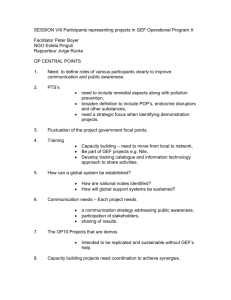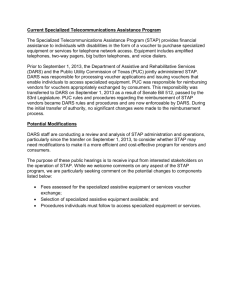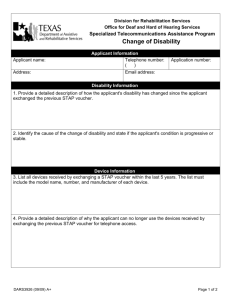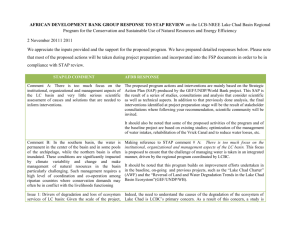Discussion Brief: Proposed Changes to STAP's Role in the GEF
advertisement
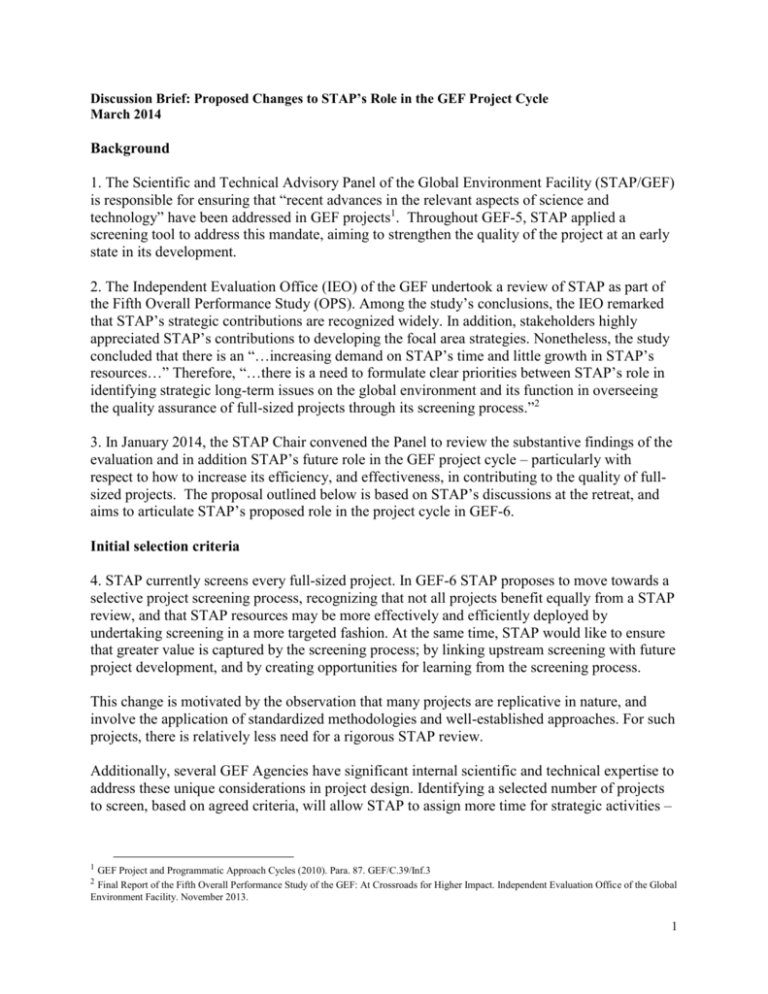
Discussion Brief: Proposed Changes to STAP’s Role in the GEF Project Cycle March 2014 Background 1. The Scientific and Technical Advisory Panel of the Global Environment Facility (STAP/GEF) is responsible for ensuring that “recent advances in the relevant aspects of science and technology” have been addressed in GEF projects1. Throughout GEF-5, STAP applied a screening tool to address this mandate, aiming to strengthen the quality of the project at an early state in its development. 2. The Independent Evaluation Office (IEO) of the GEF undertook a review of STAP as part of the Fifth Overall Performance Study (OPS). Among the study’s conclusions, the IEO remarked that STAP’s strategic contributions are recognized widely. In addition, stakeholders highly appreciated STAP’s contributions to developing the focal area strategies. Nonetheless, the study concluded that there is an “…increasing demand on STAP’s time and little growth in STAP’s resources…” Therefore, “…there is a need to formulate clear priorities between STAP’s role in identifying strategic long-term issues on the global environment and its function in overseeing the quality assurance of full-sized projects through its screening process.”2 3. In January 2014, the STAP Chair convened the Panel to review the substantive findings of the evaluation and in addition STAP’s future role in the GEF project cycle – particularly with respect to how to increase its efficiency, and effectiveness, in contributing to the quality of fullsized projects. The proposal outlined below is based on STAP’s discussions at the retreat, and aims to articulate STAP’s proposed role in the project cycle in GEF-6. Initial selection criteria 4. STAP currently screens every full-sized project. In GEF-6 STAP proposes to move towards a selective project screening process, recognizing that not all projects benefit equally from a STAP review, and that STAP resources may be more effectively and efficiently deployed by undertaking screening in a more targeted fashion. At the same time, STAP would like to ensure that greater value is captured by the screening process; by linking upstream screening with future project development, and by creating opportunities for learning from the screening process. This change is motivated by the observation that many projects are replicative in nature, and involve the application of standardized methodologies and well-established approaches. For such projects, there is relatively less need for a rigorous STAP review. Additionally, several GEF Agencies have significant internal scientific and technical expertise to address these unique considerations in project design. Identifying a selected number of projects to screen, based on agreed criteria, will allow STAP to assign more time for strategic activities – 1 GEF Project and Programmatic Approach Cycles (2010). Para. 87. GEF/C.39/Inf.3 Final Report of the Fifth Overall Performance Study of the GEF: At Crossroads for Higher Impact. Independent Evaluation Office of the Global Environment Facility. November 2013. 2 1 scoping global environmental challenges, identifying ways to address these priorities, and, more generally, contributing further to the GEF’s ability to generate global environmental outcomes. 5. The projects to be screened by STAP could be selected based on the following criteria3: (a) The project supports novel intervention approaches, or technologies, that are being piloted. This includes approaches that are new in a field, new in a particular application area or context, and/or interventions that have not been previously supported by the GEF. (e.g. UNDP proposal “Strengthening Management Effectiveness and Resilience of Protected Areas to Safeguard Biodiversity Threatened by Climate Change”4) (b) The project focuses on a thematic area or a strategic objective that is new to the GEF, and can help in addressing scientific and policy gaps. (e.g. Reduction or elimination of anthropogenic emissions and releases of mercury to the environment) (c) The project seeks resources from one of the integrated approach pilots (IAP’s), which are: i) Sustainable Cities – Harnessing Local Action for Global Commons; ii) Taking Deforestation out of Commodity Supply Chains; and, iii) Fostering Sustainability and Resilience for Food Security in Africa. (d) The project demonstrates complex and innovative integrated approaches. These include multiple focal area and multi-trust fund projects, or programmatic approaches. For the latter, STAP will review the umbrella programmes, as well as those sub-projects that are scientifically/technically challenging– for example, as described in (a) and (b). 6. The screens will focus on the sections of the Project Information Form (PIF) that include scientific and technical issues critical to project development. These sections include the project framework (logic model), baseline, incremental/additional cost reasoning, and global environmental benefits/adaptation benefits. STAP will examine these sections with regard to issues such as: Is the project objective consistent with the problem; is there a scientifically valid baseline; are global environmental benefits, or adaptation benefits, scientifically valid and adequately characterized? These aspects are defined further in the STAP screening matrix (Annex 1). The selection process 7. The projects to be screened by STAP will be identified as follows: 3 It is proposed that the criteria be refined by a small working group between the Secretariats (STAP and GEF) + one STAP member, and presented to STAP in a revised paper. The paper will then be shared for comment to GEF Agencies and the GEF Council. 4 STAP considered this project to be innovative and ground breaking - with potential for the development of effective and transformative approaches in addressing climate resilience challenges in protected area management. The approach also was considered as having high replication potential within the GEF protected area portfolio. 2 (a) As the work program is being assembled by the GEF Secretariat, the GEF Secretariat and/or GEF Agencies will identify projects that would benefit from a STAP screen based on the criteria identified in paragraph 5 a – d above5. (b) The STAP will assess the GEF work program once constituted, and identify projects that are scientific and technically challenging that warrant a review by STAP that may not have been pre-identified under paragraph 7a above6. (i) For projects financed by the Special Climate Change Fund (SCCF), the GEF Secretariat and STAP will identify projects that merit further scrutiny by STAP during the PIF pre-selection process that recommends developing the concepts for the work program. (ii) For projects financed by the Least Developed Countries Fund (LDCF), the GEF Secretariat and STAP will monitor the rolling work-program for technically challenging projects. (c) Once the work program is posted on the GEF website (or circulated electronically in the case of LDCF projects), the GEF and LDCF/SCCF Councils may also exercise their prerogative to identify projects they specifically wish STAP to review. The steps for each option will be defined further by the working group established between the Secretariats and STAP. In its regular report to the Council, the STAP will detail its selection of projects. On the horizon: Monitoring systems to assess the impact of STAP screens on project design and implementation, and harmonizing the STAP and the GEF reviews 8. There are a number of issues the GEF and STAP Secretariats may need to address jointly in the upcoming year. The activities are as follows: (a) The Secretariats, along with the Independent Evaluation Office of the GEF, may wish to consider establishing a monitoring system to assess and follow the impact of STAP’s screens on project design, particularly those where major revisions were recommended. The assessment could be undertaken when the project is fully developed, and submitted for CEO endorsement. STAP could include a brief analysis of the uptake of its advice in the project design, including lessons learned, in its regular reports to Council. (b) The Secretariats may need to harmonize the content of the STAP screen and the GEF Secretariat review sheet. (Annex 2 and 3) This task will aim to strengthen the complementarities between the reviews. The task forces provide STAP an opportunity to learn about the Agencies’ project concepts. Therefore, the task forces facilitate opportunities for STAP to engage early in the concept development process by: i) recognizing concepts that could benefit from early reviews by STAP (at the request of the Agency(ies) and in coordination with the GEF Secretariat), and; ii) identifying projects that merit a STAP review when they are submitted to the work program. Engaging with the task forces on concept development also will help develop an understanding between the GEF Secretariat, Agencies and STAP what projects are likely to merit a STAP review. 5 6 The working group will need to consider the unique project approval process for World Bank projects in this context. 3 (c) The Secretariats, along with the Panel, should consider appropriate revisions to the Targeted Research Policy for inclusion in the revised GEF Project and Programmatic Approach Cycles paper. The timeline for these activities will be in the medium-term and will be defined further later this year. Conclusion/Recommendation The STAP will work with the GEF Secretariat, Agencies, and in particular the GEF Council to reach consensus on STAP’s future role in the project cycle. This paper will be used as STAP’s input into these discussions. The final iteration of this paper will form the basis of STAP’s contribution to the GEF paper on the project cycle to be presented to the Council at their meeting in October 2014. 4
